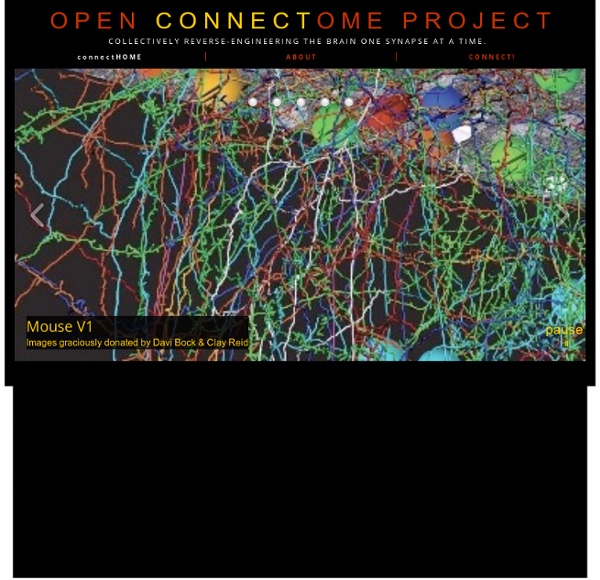



The Connectome — Harvard School of Engineering and Applied Sciences Lead investigators Hanspeter Pfister (SEAS ), Jeff Lichtman (FAS/Molecular & Cellular Biology, Center for Brain Science) and Clay Reid (HMS/Neurobiology, Center for Brain Science) Description The overall goal of the Connectome project is to map, store, analyze and visualize the actual neural circuitry of the peripheral and central nervous systems in experimental organisms, based on a very large number of images from high-resolution microscopy.
Neur-one The Brain CONNECT Project Connectomics Connectomics is the production and study of connectomes: comprehensive maps of connections within an organism's nervous system, typically its brain or eye. Because these structures are extremely complex, methods within this field use a high-throughput application of neural imaging and histological techniques in order to increase the speed, efficiency, and resolution of maps of the multitude of neural connections in a nervous system. While the principal focus of such a project is the brain, any neural connections could theoretically be mapped by connectomics, including, for example, neuromuscular junctions. Tools[edit] Model Systems[edit] Aside from the human brain, some of the model systems used for connectomics research are the mouse,[3] the fruit fly,[4] the nematode C. elegans,[5][6] and the barn owl.[7] Applications[edit] Criticism[edit] Comparison to genomics[edit] See also[edit] References[edit] Further reading[edit] External links[edit]
Neuranat Morphologie Ce chapitre aborde les bases de l'anatomie descriptive du crâne, des méninges et du système nerveux central. Atlas Ce chapitre propose des atlas anatomiques interactifs dans les trois plans, un atlas neuroradiologique avec curseur 3D synchronisé dans les trois plans de l'espace et un atlas du tronc cérébral de l'espace neuroradiologiques, montrant un point choisi au niveau du cerveau simultanément dans les 3 plans de l'espace et sur une reconstruction 3D ainsi qu'un atlas du tronc cérébral. Vidéos Le chapitre Vidéos constitue un véritable atelier de dissection du cerveau grâce à des documents richmédia associant simultanément vidéo, images et textes. Animations Retrouvez des animations concernant la fissure choroïdienne, le fornix et le quatrième ventricule et un "serious game", Dyn@slice, permettant de s'exercer à remettre dans l'ordre des coupes de cerveau. © UPMC.
70,000+ Have Played ‘Eyewire’ Game That Trains Computers To Map the Brain Your connectome, the map of all 86 billion connected neurons in your brain, is hopelessly complex. In fact, one human connectome has a staggering 10,000 times that number of neural pathways. Every thought you have and every memory you hold exists in your connectome, and major efforts are under way to map it. The good news is that you don’t need a fancy neuroscience degree to help out. In fact, the fancy degreed neuroscientists are hoping that you might pitch in. Created by scientists at MIT, Eyewire is a browser game that lets players take on the challenge of mapping neural pathways in brains — no scientific background required. In an amplifying way, the team at MIT hopes that these human assisted computers will one day learn to map neurons by themselves. To date, over 70,000 gamers from over 100 countries have signed up to play Eyewire, and it’s a good thing they did. Mapping the connectome will be considerably more challenging than mapping the genome, but the lesson learned holds true.
home Brain Research through Advancing Innovative Neurotechnologies (BRAIN) NIH Home > Research & Training What is the BRAIN Initiative? The Brain Research through Advancing Innovative Neurotechnologies (BRAIN) Initiative is part of a new Presidential focus aimed at revolutionizing our understanding of the human brain. A map of overall task-fMRI brain coverage from the seven tasks used in the Human Connectome Project. THE BRAIN INITIATIVE and BRAIN RESEARCH THROUGH ADVANCING INNOVATIVE NEUROTECHNOLOGIES are service marks of the U.S. Meeting Information May 29, 2013, San Francisco, CA Focus: Molecular approaches View the Agenda June 26, 2013, New York, NY Focus: Large-scale recording technologies View the Agenda July 29, 2013, Boston, MA Focus: Computation, theory, and big data View the Agenda August 29, 2013, Minneapolis, MN Focus: Human Neuroscience View the Agenda This page last reviewed on April 9, 2014
IBM scientists create most comprehensive map of the brain’s network "The Mandala of the Mind": The long-distance network of the Macaque monkey brain, spanning the cortex, thalamus, and basal ganglia, showing 6,602 long-distance connections between 383 brain regions. (PNAS) The Proceedings of the National Academy of Sciences (PNAS) published Tuesday a landmark paper entitled “Network architecture of the long-distance pathways in the macaque brain” (an open-access paper) by Dharmendra S. Modha (IBM Almaden) and Raghavendra Singh (IBM Research-India) with major implications for reverse-engineering the brain and developing a network of cognitive-computing chips. “We have successfully uncovered and mapped the most comprehensive long-distance network of the Macaque monkey brain, which is essential for understanding the brain’s behavior, complexity, dynamics and computation,” Dr. Modha says. The center of higher cognition and consciousness? Core subnetwork (PNAS) Prefrontal cortex: integrator-distributor of information Dr. Amara D.